ISSN 0976 - 0075
As sedentary life style is increasing there is increase in the incidence of low backache of which one commonest condition is Sacroiliitis. Sacroiliitis means inflammation of sacroiliac joint which causes symptoms as severe low backache, tingling numbness, difficulty in walking etc. In modern medicine pain killers, steroidal injection in sacroiliac joint etc are the only line of treatment followed which have many side effects and give only temporary relief. In Ayurveda Jalaukavacharana is very helpful in reducing pain and swelling. In Ashtang hruday Acharya has mentioned to do raktamokshan if patient do not get relief after snehan, swedan and other treatments. Jalauka was chosen for raktamokshan as it has many anti-inflammatory enzymes in its saliva and can be used in all patients. Three settings of Jalaukavacharana at interval of 15 days were done and results observed.
Keywords: Jalaukavacharana, Sacroiliitis
Introduction
Sacroiliitis – itis means inflammation
Inflammation of one or both sacroiliac joints – situated where your lower spine and pelvis connect. Sacroiliitis can cause pain in your buttocks or lower back, and can extend down one or both legs. Prolonged standing or stair climbing can worsen the pain. Pain caused by Sacroiliitis can be related to either too much or not enough motion in sacroiliac joint that makes it less a pathological diagnosis and more a patho mechanical diagnosis.
The SIJ forms the lowest segment of the spinal axis and distributes the forces coming from the upper body. Movements occurring in SIJ play an important role in distributing forces and is influenced by the movements of the lumbosacral spine.
The SIJ is a true diarthrodial joint. The articular surfaces are separated by a joint space containing synovial fluid and enveloped by a fibrous capsule. It has unique characteristic not typically found in other diarthrodial joints. The SIJ consists of fibrocartilage in addition to hyaline cartilage and is characterized by discontinuity of the posterior capsule with ridges and depressions that minimize movement and enhance stability. The SIJ has been described as a synovial joint only in the anterior portion in contrast to the posterior portion. The posterior connection is a syndesmosis consisting of the ligament sacroiliaca, the gluteus medius and minimus and the piriformis muscles.
Etiology
Spondylo arthro pathies- ankylosing spondylitis, reactive arthritis, psoriatic arthritis, arthritis of chronic inflammatory bowel disease and undifferentiated spondylo arthropathy.
Symmetrical Sacroiliitis is found in more than 90% of ankylosing spondylitis and 2/3 in reactive arthritis and psoriatic arthritis.
It is less severe and more likely to be unilateral and asymmetrical in reactive arthritis, psoriatic arthritis, arthritis of chronic inflammatory bowel disease and undifferentiated spondyloarthropathy.
Also traumatic injuries, infection, inflammatory conditions like rheumatoid arthritis, degenerative joint diseases, metabolic conditions like gout and even pregnancy can cause Sacroiliitis.
In modern medicine pain killers, steroidal injection in sacroiliac joint etc are the only line of treatment followed which has many side effects and gives only temporary relief. Jalaukavacharanais a potent remedy for pain in Ayurveda. It has been found that most of the contents present in its saliva have anti- inflammatory action which help in reducing pain and inflammation of the affected area. Following are the contents in saliva of jalauka:
|
Contents |
Effect on the host |
|
|
|
|
Hirudin |
Inhibits blood coagulation by binding to thrombin |
|
Calin ( saratin ) |
Inhibits blood coagulation by blocking the binding of von willebrand factor to collagen inhibits collagen-mediated platelet aggregation |
|
Destabilase |
Monomerizing activity Dissolves fibrin Thrombolytic effects |
|
Hirustasin |
(serine proteinase ) Inhibits kallikrein, trypsin, chymotrypsin, and neutrophiliccathepsin G |
|
Bdellins |
Anti-inflammatory Inhibits trypsin, plasmin, and acrosin. |
|
Hyaluronidase |
(“spreading factor”) Increases interstitial viscosity Antibiotic |
|
Leech- derived tryptase inhibitor |
( Tryptase inhibitor ) Inhibits proteolytic enzymes of host mast cells |
|
Eglins |
Anti-inflammatory Inhibits the activity of α-chymotrypsin, chymase, subtilisin, elastase, and cathepsin G |
|
Factor Xa inhibitor |
Inhibits the activity of coagulation factor Xa by forming equimolar complexes |
|
Complement inhibitors |
May possibly replace natural complement inhibitors if they are deficient. |
|
Carboxypeptidase A inhibitors |
Increases the inflow of blood at the bite site |
|
Histamine like substances |
Vasodilator. Increases the inflow of blood at the bite site |
|
Acetylcholine |
Vasodilator |
|
Anesthetic substance |
Anesthetic |
Case History
A 48 year female patient visited to shalya OPD with complaints of pain in buttocks radiating to posterio-lateral aspect on the thigh more on right side compared to left, tingling numbness, intolerance with sitting and increasing pain while climbing stairs. On physical examination distraction, thigh trust, FABER, compression, gaenslen’s test were positive. Local tenderness was positive. In X- Ray there was minimal sclerosis with some erosion at sacroiliac joint.
Grading of sacroiliitis using plain radiographs according to the New York criteria:
Grade 0: normal
Grade 1: some blurring of the joint margins – suspicious
Grade 2: minimal sclerosis with some erosion
Grade 3: definite sclerosis on both sides of joint
Severe erosions with widening of joint space with or without ankylosis
Grade 4:complete ankylosis
According to above gradation above case comes under grade 2 of sacroiliitis.
P/M/H-No H/O DM, Hypertension, Koch’s or any other systemic disease.
P/S/H- No H/O any kind of major or minor operative done.
H/O Addiction- No history of any kind of addiction noted.
H/O Drug Allergy- No history of any kind of specific drug allergy noted.
General Examination
General condition- fair
Afebrile
BP- 110/70 mm Hg
Pulse- 84/min
CVS – S1S2 normal audible
CNS – conscious oriented
RS – AEBE, Clear.
Aim
Efficacy of Leech Therapy in Sacroiliitis.
Type of Study
Interventional open single case study.
Material and Methods
Material
Hirudomedicinalis leeches
Haridra
Yashtimadhu
Saindhav
Needle
Gauze piece
Bowl
Water
Method
Hirudomedicinal is leeches which are indicated for medicinal use are applied locally i.e. at the right sacroiliac region three times at the interval of 15 days.
Selection of Leech (Hirudomedicinalis):
Out of twelve, only six varieties of non-poisonous leeches are used for medicinal purpose. Sankumukhi type of leech is preferably used for medicinal purposes due to its rapid blood sucking capacity. As per classical description of Ayurveda,Leeches used for the therapy were obtained from fresh water pond of medium size(4-6gms weight). 3 Leeches were applied once in every 15 days for three times.
Storage and maintenance Leech:
Leech should be stored in well labeled container having multiple pores on the top for proper aeration. Temperature should be maintained around 15-27º C. The water of container should be de- chlorinated and should be replaced after 5 to 6 day. About 50 leeches can be kept in one gallon (4 liter) of water. If it is not possible to get the de-chlorinated water then keep the container of chlorinated water open in the air for a period of time and then use it for storage of leech. It is better to avoid direct exposure of sunlight to the leeches.
Preparation:
To activate the Leeches as well as to make the skin of leeches antiseptic they were put in a bowl containing a solution of Haridra and water for a period of 15 minutes. Later on Leeches were cleaned by keeping them in another bowl of pure water for15 minutes.
Position:
The patients were advised to lie down in supine position.
Procedure:
The posterior sucker of leech was held in one hand and anterior sucker was placed at site of application (maximum tenderness), where the leech was expected to be fixed.Thereafter, the posterior sucker was released from the hand & attached to the surrounding skin surface of the joint. Thereafter, the leeches were covered with wet gauze piece. To keep it moist, few drops of water was poured on & off. As soon as the leeches showed the sign of elevated head & pumping action of the anterior sucker region the time was noted, when the leeches got detached spontaneously or otherwise, the time was once again noted. After leeches get detached, the site of application was properly cleaned, thereafter, sprinkling of Madhuyasti powder was done followed by tight bandaging of the wound.
Precaution:
With the onset of symptoms like burning, itching, pain etc., the leeches were removed by sprinkling Haridra powder or Saindhav.
Contra indication of leetch therapy:
Criteria of Assessment
Patient was assessed according to following criteria:
Visual analogue scale-
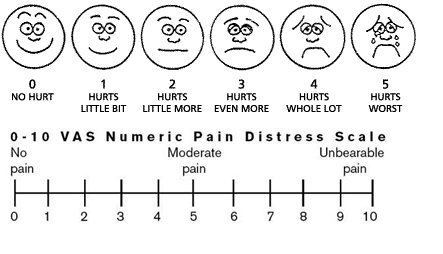
|
+1/4T,orgrade1/4tenderness |
Tenderness with no physical response |
|
|
|
|
+2/4T,orgrade2/4tenderness |
Tenderness with grimace, wince and/or flinch |
|
|
|
|
+3/4T,orgrade3/4tenderness |
Tenderness with withdrawal(positive jump sign) |
|
|
|
|
+4/4T,orgrade4/4tenderness |
Non-noxious stimuli(e.g. superficial palpation, gentle percussion)results in patient withdrawal or patient refusal to be palpated due to pain |
Results
On first visit severity of pain on visual on visual analogue scale was 8 and that after first session of jalaukavacharana came down to 4 and was zero at the end of last session.
Severity of Tenderness on first visit was 2 on tenderness grading scale that after first session of jalaukavacharana reduced to grade 1 that is tenderness with no physical response and zero at the end of last session.
X ray of hip joint showed no more sclerosis or erosions.
On physical examination distraction, thigh trust, FABER, compression, gaenslen’s test were negative.
Conclusion
There were significant clinical improvements after raktamokshan with jalauka.
3 follow ups were taken on monthly basis after completion. The results sustained themselves.
As the patient was not taking any treatment for 2 months before starting jalaukavacharana and as there were no supplementary treatments along with jalaukavacharana the results were most probably due to raktamokshan by jalauka.
*M.S, Scholar Shalyatantra Department
**M.D, Professor H.O.D Shalya -Tantra Department, Dean, Dr G D Pol Foundation’s YMT Ayurvedic Medical College and Hospital, P.G. Institute Kharghar, Navi Mumbai.
References
1] Sushrut Samhita, edited by Dr. Anantram Sharma, ChaukhambaSurbharatiPrakashana, Varanasi, 2013.
2] Ashtangahrdayam of vagbhata edited with the ‘vidyotini’ hindi commentary by kavirajaatridevaguptavidyalankara, bhisagratna edited by Vaidya yadunandanaupadhyaya. Chaukhambhaprakashan Varanasi.
3] Musculoskeletal key fastest musculoskeletal insight engine.
4] Tenderness grading by university of western states college of chiropractic clinic protocol adopted:11/95 Revised: 10/96, 2/11, 8/14.
Photos:
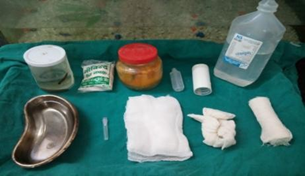
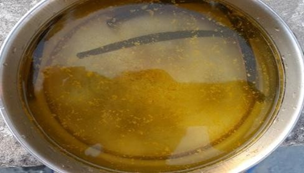
Materials for JalaukavacharanaVidhi Activation of Jalauka with Haridra
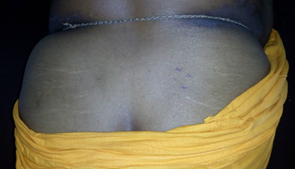
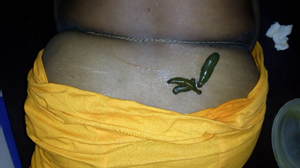
Marking point of Jalaukavacharana Jalaukavacharana
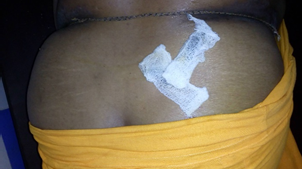
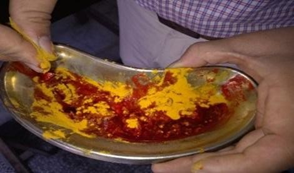
Covering Jalauka with wet gauze Vaman of Jalauka
Download Article